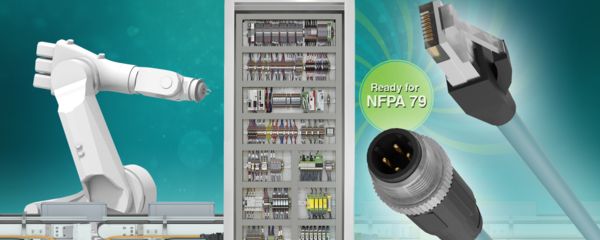High-flex Ethernet cordsets

High-flex Ethernet cordsets are now a part of the North American cabling portfolio. The increased complexity of automated processes is driving demand for network cables that can do more in a limited amount of space. Ethernet cables and cordsets can be run next to power circuits, have Power over Ethernet (PoE) capability, and have increased longevity in demanding industrial and robotic applications.
In addition to where Ethernet cables can go, what Ethernet cables can do is also expanding. Flex ratings (with a proper bend radius) have increased to allow for use beyond static applications. PoE is also changing the way Ethernet cables are used. Already in use in the commercial world for devices such as surveillance cameras, PoE is growing in popularity for the industrial world as well. Our cable material is PoE-compliant when installed per recommendations in TIA TSB-184. As Ethernet networking continues to grow, its use is increasing in industrial areas where equipment is close to high-voltage cabling. Our 600 volt-rated UL AWM 2463 Ethernet cable jacket meets NFPA 79 requirements to be run together with high-voltage power and signal cables. This benefit not only saves space, but also saves cost by eliminating the need to route Ethernet cables in separate paths.
One of the biggest strengths of the Phoenix Contact North American program is the ability to provide local production and service through our facility in Harrisburg, PA. No borders, no added logistics.
Your advantages
- Lateral flex bend cycles: Up to 20 million cycles; Torsional flex cycles: Up to 4.8 million cycles
- Voltage rating (cable jacket): 600 V
- Wire size: 24 AWG
- Shielding style: SF/UTP
- Temperature range: -40° to 80°C
- Category CAT5 (IEC 11801), up to 1 Gbps
- UV-resistant outdoor CMX-rated jacket is resistant to welding splashes
![M12 4-position D-code [93F] M12 4-position D-code [93F]](https://caas.phoenixcontact.com/caas/v1/stable/media/313036/full/b700?format=jpg)
M12 4-position D-code [93F]
The M12 D-code is the industrial standard for 100 Mbps Ethernet. The cable is constructed of two unshielded twisted pairs, with an overall foil and braided shield. Many IP67 I/O boxes integrate the D-code M12 as the physical layer interface to the Ethernet network.
Lateral flex bend cycles: Up to 20 million
- Lateral flex bend cycles: Up to 20 million
- Torsional flex cycles: Up to 3 million
![M12 8-position A-code [94L] M12 8-position A-code [94L]](https://caas.phoenixcontact.com/caas/v1/stable/media/313034/full/b700?format=jpg)
M12 8-position A-code [94L]
The M12 A-code is the adopted standard for speeds requiring closer to 1 Gbps Ethernet. The cable is constructed with four unshielded twisted pairs, with an overall foil and braided shield. Many IP67 cameras and vision systems integrate the A-code M12 as the physical layer interface to the Ethernet network.
- Lateral flex bend cycles: Up to 10 million
- Torsional flex cycles: Up to 4.8 million
![RJ45 Ethernet patch cables [93E and 94L] RJ45 Ethernet patch cables [93E and 94L]](https://caas.phoenixcontact.com/caas/v1/stable/media/313030/full/b700?format=jpg)
RJ45 Ethernet patch cables [93E and 94L]
The industrial RJ45 patch cable is the go-to Ethernet connection within an IP20 cabinet. The cables are constructed with either two or four unshielded twisted pairs, and an overall foil and braided shield. Our 600 volt-rated UL AWM 2463 Ethernet cable jacket meets NFPA 79 requirements to be run together with high voltage power and signal cables. Most industrial Ethernet unmanaged or managed switches integrate RJ45s as the physical layer interface to the Ethernet network.

Cable reels
The TPE material used in these cables is also offered in bulk reels. This option pairs perfectly with our easy color-coded field-wired connectors (available in push-in or QUICKON IDC technology). Standard lengths of material on the reel are available in 100 or 300 meters.
